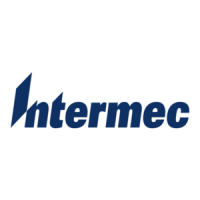Intermec EasyCoder F2 – Installation & Operation Ed. 2 43
Chapter 6 Setting Up the Printer
Setup Parameters, cont'd.
Serial Communication,
cont'd.
Character Length
The character length specifi es the number of bits in a character.
For most purposes 7 bits will be suffi cient, but if special characters
or characters specifi c for other languages are to be used, 8 bits are
recommended. Refer to the Intermec Fingerprint 7.xx Reference
Manual for information on which characters are available in various
combinations of character length and character set.
• 7 Characters ASCII 0 – 127 decimal
• 8 Characters ASCII 0 – 255 decimal (default)
Parity
The parity decides how the fi rmware will check for transmission
errors. There are fi ve options:
• None (default)
• Even
• Odd
• Mark
• Space
Stop Bits
The number of stop bits specifi es how many bits will defi ne the end
of a character. There are two options:
• 1 (default)
• 2
Flow Control
• RTS/CTS
RTS/CTS is a protocol where the communication is controlled by
currents through separate lines in the cable being set either to high
or low. By default, this option is disabled.
RTS high indicates that the transmitting unit is able to receive
characters. RTS low indicates that the receive buffer is fi lled
to 75% (see XON/XOFF).
CTS high indicates that the unit transmitting the CTS signal is
ready to receive data. CTS low indicates that the receive buffer
is full (see XON/XOFF). In some computer programs, e.g. MS
Windows Terminal, RTS/CTS is designated “Hardware”.'

